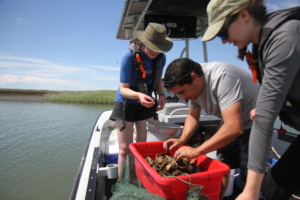A team led by the Smithsonian Environmental Research Center (SERC) and Marine Global Earth Observatory (MarineGEO), and including participants from Virginia Institute of Marine Science (VIMS), University of Maryland (UMD), Old Dominion University (ODU) George Mason University (GMU), and several other institutions conducted a large initiative to document the biodiversity of the Chesapeake Bay on July 15th to the 28th. A team of about 30 scientists took photographs, genetic barcodes, frozen tissue samples, and voucher specimens of Bay species across the watershed for the National Museum of Natural History.
The project, called the Chesapeake Bay Barcode Initiative, will develop a barcode library of fish and macro-invertebrates across the Bay. Genetic barcoding will create a database of genetic samples, which includes analyzing segments of DNA from a range of organisms, that can be used to identify species from small bits of tissue, including tissue that’s been partially digested in the stomachs of fish. In total, Chesapeake Bay is habitat for over 300 species of fish and 1000 macro-invertebrates.

The photo was taken near Wachapreague, VA and shows (L to R) Julie Englund (SERC intern), Rob Aguilar (SERC Biological Technician leading the project) and Gabriella Marafino (SERC Biological Technician) using the barcoding technique. Credit to SERC.
The team has collected barcodes from about two-thirds of the fish species, about 80% of decapods and mollusks, and about 10-15% of the rest of the invertebrates. Their goal is to barcode at least 80% of fish and macro-invertebrates in the Bay, sampling from salt and freshwater areas.
They want to use the samples to create a baseline understanding of biodiversity of the Bay and to construct more complete food webs. One of the project’s leaders, Matt Ogburn of SERC, explains “if somebody wants to come back in 20 years and understand how the Bay has changed with climate change…[this] gives them a nice snapshot of what the biodiversity of the region is.”
The database could also be used on a global scale, helping scientists all over the world better understand where species come from, particularly invasives. For example, Ogburn’s team recently used their samples to figure out the difference between a soft clam in the Bay and one in Asia, which were long thought to be the same species. The genetic samples helped prove that they were actually two different species. Having a database like this can “answer how Chesapeake Bay species are related to species all over the world,” says Ogburn, bringing a piece of Bay science onto the global stage.
